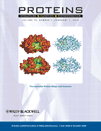The energetics of the acetylation switch in p53-mediated transcriptional activation
Abstract
Targeted therapeutic intervention in receptor-ligand interactions of p53-mediated tumor suppression can impact progression of disease, aging, and variation in genetic expression. Here, we conducted a number of molecular simulations, based on structures of p53 in complex with its transcriptional coactivating CBP bromodomain, determined by NMR spectroscopy, to investigate the energetics of the binding complex. Building on the observation that acetylation of K382 in p53 serves as the essential triggering switch for a specific interaction with CBP, we assessed the differential effect of acetylation on binding from simulations of an octapeptide derived from p53 with acetylated and nonacetylated K382 (residues 379–386). Cluster analysis of the simulations shows that acetylation of the free peptide does not significantly change the population of the preferred conformation of the peptide in solution for binding to CBP. Conversion of the acetylated K382 to nonacetylated form with free energy perturbation (FEP) simulations of the p53 CBP complex and the free peptide showed that the relative contribution of the acetyl group to binding is 4.8 kcal/mol. An analysis of residue contributions to the binding energy using an MM-GBSA approach agrees with the FEP results and sheds additional light on the origin of selectivity in p53 binding to the CBP bromodomain. Proteins 2010. © 2009 Wiley-Liss, Inc.




